|
Some genres are a lot more elastic than others. Our notions of what
a Western or a musical consists of are reasonably firm. But
thrillers tend to be all over the place, overlapping at various
times with crime films, adventure films, heist films, noirs, mystery
stories, spy stories, melodramas, and even comedies, period films,
and art movies—-to propose a far from exhaustive list.
In order to demonstrate this overall versatility, I’ve come up with
18 recommended titles that I’m listing and briefly describing below,
in alphabetical order. A dozen are in English, three are in French,
and one apiece is in German, Italian, or Japanese. All but two are
currently available on DVD, although in at least one case you’ll
have to go beyond American sources in order to acquire it. And
ironically, the two that are unavailable are both Hollywood
classics—-one more indication of the degree to which some of the
major studios and/or the inheritors of their treasures still don’t
have a very clear idea of what they possess and keep out of reach.
(NOTE: CLICK ON
TITLES, COVERS OR UNDERLINED TEXT FOR LINKS)

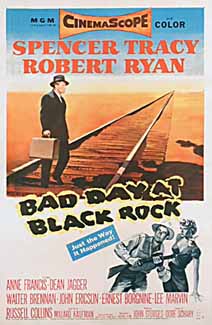 |
Bad Day at Black Rock.
My favorite John Sturges picture, an MGM CinemaScope
release of 1955, pits a slightly disabled Spencer Tracy
(he has use of only one arm, but knows karate) against
virtually an entire small southwestern desert town. The
bad day commences when he arrives at the sleepy train
station, seeking to find out what happened to a Japanese
friend of his, a World War II buddy, and nobody wants to
talk to him. Ernest Borgnine plays one of the local
toughs who tries to dissuade him from his quest by
pouring gobs of ketchup all over his food in a greasy
spoon diner, and what Tracy winds up doing in self-defense--a
burst of violence as neatly choreographed as anything
you’d find in Howard Hawks—-is alone worth the price of
admission. But Tracy’s main adversary proves to be
Robert Ryan, and it takes most of the movie’s 81 minutes
for all of the town’s baroque entanglements to be
revealed.
|
|
 |
|
Big Deal on Madonna Street.
The only pure comedy on my list is also the only pure
heist movie (unless one counts 5 Against the House, a
secondary recommendation), and so influential that that
you’ve probably already encountered certain gags from
it. (See, in particular, Crackers, the American
remake--probably the worst film Louis Malle ever
made--as well as Woody Allen’s massive borrowings in
Small Time Crooks.) This is only fair, because Mario Monicelli’s hilarious 1958 farce about a team of
bungling burglars trying to break into a safe full of
jewels is itself an elaborate parody of two very popular
heist films of the 50s, John Huston’s
The Asphalt Jungle
(1950) and Jules Dassin’s
Rififi (1955), the second of
which was clearly influenced by the first. Like many of
the best Italian movies, this is strong above all for
its characters, and the cast—-which includes Marcello
Mastroianni, Claudia Cardinale, and Vittorio Gassman—-is
first-rate.
|
 |
|
 |
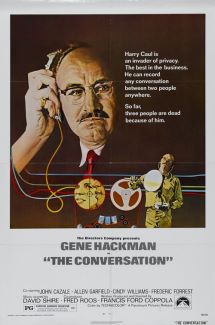 |
The Conversation.
This is perhaps the best-known item on my list, but as
the best of all thrillers about
surveillance—-specifically, about an “electronic
surveillance” sound technician working out of San
Francisco, played by Gene Hackman in what may be his
greatest performance—-it deserves to be still better
known. (It didn’t “perform” all that well at the box
office when it came out in 1974, which may account for
its relative obscurity.) Francis Ford Coppola wrote,
directed, and produced it, and it remains my favorite of
his films, even though it’s possible to conclude, after
listening to the DVD commentary of both Coppola and his
brilliant editor Walter Murch, that Murch may be the
film’s true auteur. Atmospheric, morally troubling, and
often suspenseful, this is the sort of movie you’re
likely to carry around with you long after you’ve seen
it. The excellent secondary cast includes John Cazale,
Allen Garfield, Cindy Williams, Frederic Forrest, and an
unexpected early bit part by Harrison Ford. |
|
 |
Les Espions. In
contrast to
The Conversation, this is possibly the least
well known of my selections, and a film I discovered
only recently, when I ordered a DVD of it from England.
It’s directed and cowritten by Henri-Georges Clouzot,
the only filmmaker responsible for two of my 18
selections (see
The Wages of Fear, below)—-a kind of
French Hitchcock whose view of the world was even
blacker and bleaker than Hitchcock’s. The title is
French for “The Spies,” and the setting of this very
strange and caustic 1957 picture is a run-down mental
asylum with very few patients in the sticks. The head
doctor there is offered a large sum of money from the
U.S. military in order to shelter a mysterious
physicist, and after he reluctantly agrees, a good many
international spies turn up as patients in the
establishment as well, and the paranoid Cold War
conspiracies keep growing from there in both size and
complexity. As I’ve suggested elsewhere, Clouzot’s
oddity may come closer to the absurdist humor of Franz
Kafka than any of the literal adaptations of his work,
such as Orson Welles’ version of
The Trial, and the
secondary cast is especially memorable: not only Clouzot’s wife Vera Clouzot (who also figured in his
better-known
Diabolique and
The Wages of Fear, but also
Hollywood actor Sam Jaffe (The Asphalt Jungle), English
actor Peter Ustinov (Lola Montes),
and German actor Curt Jurgens (Bitter Victory).
|
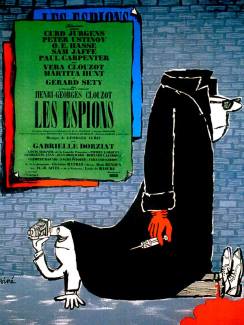 |

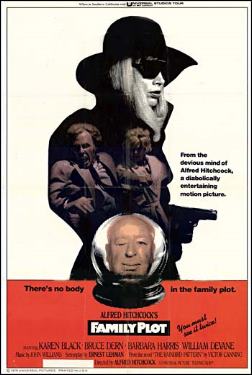 |
Family Plot. As long as we’re on the subject of Hitchcock and Hitchcockian suspense, consider this a special plug for his
underrated 53rd and final feature, frequently written off as “minor”
because it takes the form of light comedy (which is also the case
with his less suspenseful but equally underrated
The Trouble With
Harry).
Yet unlike Hitchcock’s other late films (Torn Curtain,
Topaz, and
Frenzy),
which tend to break up into set pieces, this is all of a
piece—-a superbly integrated and intricate as well as charming piece
of mischief built around two romantic couples (Bruce Dern and
Barbara Harris, Karen Black and William Devane) and a “double” plot.
The script is by Ernest Lehman, who scripted the very best of
Hitchcock’s breezy comic thrillers,
North by Northwest—a title I’ve
omitted here only because, like my other Hitchcock favorite,
Rear
Window, it’s too well known to need anyone’s recommendation. When
the French critics of the New Wave (Chabrol, Godard, Rivette,
Rohmer, and Truffaut) insisted on taking Hitchcock seriously long
before anyone else did, one of their key pieces of evidence was
Hitchcock’s very intricate use of stories involving double plots and
rhyming shots, such as
Shadow of a Doubt (as analyzed by Truffaut)
and
The Wrong Man (as analyzed by Godard).
Family Plot places this
concept front and center, and Hitchcock plays with it brilliantly,
like a perfectly composed piece of music. |
|
 |
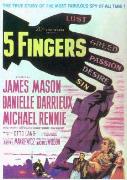 |
5 Fingers. This is one of the rare movies by Joseph L. Mankiewicz
where he doesn’t take a writing credit. The script of this ingenious
and entertaining spy thriller of 1952, another Cold War item, is
credited to Michael Wilson, and it’s a wonderful showcase for its
cast—-James Mason (in one of his best roles), Danielle Darrieux, and
Michael Rennie. An extra bonus: The score is by Bernard Herrmann. |
|
 |
|
The Killing of a Chinese Bookie. There are two versions of John Cassavetes’ postnoir masterpiece--first edited and released in 1976,
then recut and re-released in a shorter version two years later
after the first one failed miserably at the box office. (Lamentably,
the second version failed as well.) It’s hard to choose between
them, but I tend to opt for the earlier, longer, and, until
recently, harder to see of the two versions, both of which are now
available in
Criterion’s excellent Cassavetes box set. The hero,
Cosmo Vitali--a flashy owner of a Los Angeles strip joint,
beautifully played by Ben Gazzara, both a stupid asshole and a kind
of saint—gambles his way into serious debt, and finds he has
to fulfill a contract to bump off a Chinese bookie in order to settle
his accounts. This leads to one extended suspense sequence, but
basically this movie can also be read as a personal allegory by Cassavetes, a self-portrait about himself as an embattled impresario
and father figure to a precarious showbiz collective who has to do
dirty stuff in order to keep his family afloat (much as Cassavetes
had to act in Hollywood pictures in order to finance his own movies,
including this one). It even concludes--self-consciously but
magnificently –-with Cassavetes’ self-adopted theme song, “I Can’t
Give You Anything But Love,” clearly the motto of his entire work as
a filmmaker. |
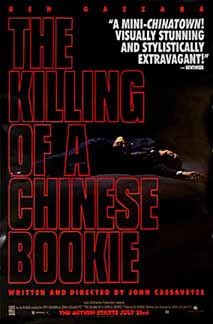 |

|
|
M. As far as I’m concerned, Fritz Lang’s first talkie (1931) remains
not only his greatest film but also the best serial killer movie
ever made by anyone. It also has the best performance to be found in
any Lang film—-Peter Lorre as a crazed murderer of children who
terrorizes a city to such a degree that ultimately both the local
gangsters as well as the local police have to pool their resources
in order to track him down. The suspense we expect from such a story
is certainly present; but it’s also, as in the best Hitchcock films,
a kind of moral ambiguity designed to trouble and provoke us into
reflecting where we belong in Lang’s scheme of the way the world
works. The geometry of the plot, compositions, and editing is as
breathtaking as Lorre’s terrifying portrait at the dead center of
the film. |
 |

Miami Blues. The cult crime-thriller writer Charles Willeford
crowned his career by writing four superb novels centered around a
Miami-based homicide detective, Hoke Moseley: Miami Blues (1984),
New Hope for the Dead (1985), Sideswipe (1987), and
The Way We Die
Now (1988). Individually and collectively, they do almost as good a
job of describing “the way we live now” as John Updike’s four novels
about Rabbit Angstrom, written over a much longer period. My favorite among the Hoke Moseley novels—-certainly the scariest, and
possibly the best constructed—is Sideswipe. But Miami Blues is the
first, and George Armitage’s 1990 film adaptation is one of the best
literary adaptations I can think of. The cast is perfect: Alec
Baldwin as an ex-con and small-time thief who arrives in Miami,
hooks up with a local prostitute (Jennifer Jason Leigh), and winds
up stealing the gun, badge, and dentures of Moseley (Fred Ward) to
pose as a cop while pulling off more of his jobs. The humor and
pizzazz of this, as well as the use of locations, call to mind Godard’s
Breathless.
|
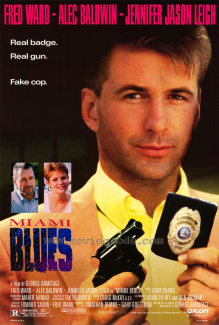 |

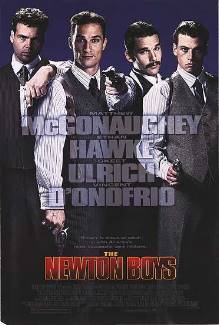 |
The Newton Boys. Many people have declared Richard Linklater’s first
big-budget movie (1998)--a period recreation of and tribute to the
most successful bank robbers in U.S. history, brothers from Texas,
who thrived between 1919 and 1924—-to be anything but thrilling. I
obviously don’t agree with them, but I have to admit that the very
notion of a gentle and relatively non-violent movie about bank
robbers who never killed anyone is almost a contradiction in terms,
at least when it comes to generic thrillers. This is part of
Linklater’s point—-a nongeneric point, one might say--and it’s why,
when I originally reviewed this film for the
Chicago Reader, I
compared it to Francois Truffaut’s
Jules and Jim, which has a
similar light and elegiac touch There’s also something about Linklater’s fascination with the way American looked in the teens
and 20s that inspires meditation rather than suspense. But insofar
as suspense in any movie is partially a matter of eagerly awaiting
what comes next, I have to say that this is a thriller that
continues to thrill me. |

|
99 River Street. One of the most underrated thriller and noir
specialists in American cinema is Phil Karlson, the Chicago-born
director of
Tight Spot
(1955), 5 Against the House (1955), The Phenix City Story (1955), and
The Brothers Rico (1957), among many other gems.
The first of these features Ginger Rogers as a sassy
convict; the second is an ingenious Jack Finney
adaptation and sexy Kim Novak vehicle about a bunch of
college jocks who contrive a way to rob Harold’s Club in
Reno; and the third is my candidate for the best movie
ever shot on location in Alabama, while the fourth, as I
recall, is an excellent thriller about a former Mafia
bookkeeper (Richard Conte) trying to go straight.
Only the
first of these is available (in
Japan or the
UK!), and a
particularly regrettable absence is the earlier
99 River Street
(1953), which
follows the unpredictable and exciting adventures of a
boxer-turned-cabbie and cuckold (John Payne) over one crazy night in
New York City. Critic Dave Kehr once aptly called it "an example of
the kind of humble brilliance that often emerged from the American
genre cinema”; it costars Evelyn Keyes. |
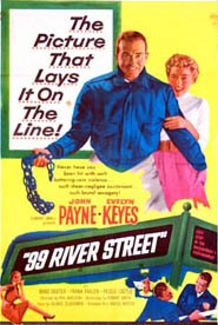 |

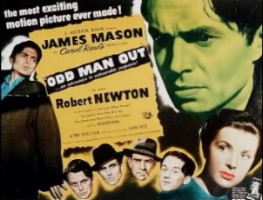 |
Odd Man Out. James Mason, again at his near best, plays an Irish
revolutionary on the run in Belfast, meeting with a broad spectrum
of human responses ranging from indifference to empathy (once again,
over a single night). Carol Reed’s 1946 English thriller, adapted
from a novel by F.L. Green, is the artiest of all the films I’ve
selected, and it’s come to have a mixed reputation due to its
allegorical pretensions and some of its fancier visual conceits. But
as James Agee pointed out, it catches the feel of a city at night
with indelible poetry and intensity, and Robert Krasker’s black and
white cinematography is good enough to make you think of Orson
Welles’ work with Gregg Toland and Stanley Cortez on
Citizen Kane
and
The Magnificent Ambersons. The secondary cast—-including such
standbys as Cyril Cusack, F.J. McCormack, Robert Newton, Dan
O’Herlihy, and Kathleen Ryan--is sublime. |

|
Panic in the Streets. Before Elia Kazan became famous as a film
director (he was already a seasoned stage director), he made a
couple of interesting and effective thrillers shot on
locations—Boomerang (1947) in Connecticut and this taut tale, which
is even better, about a public health doctor (Richard Widmark)
trying to track down a bunch of thieves who may be infected with
bubonic plague, in New Orleans. Edward and Edna Anhalt won an Oscar
for their original story, and the backup cast includes Barbara Bel
Geddes, Paul Douglas, Jack Palance, and Zero Mostel. |
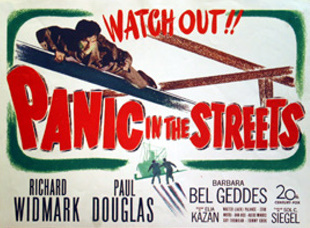 |

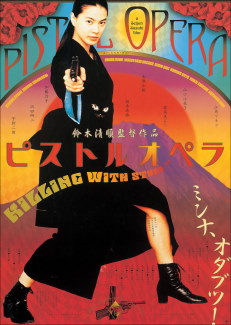 |
Pistol Opera.
Odd Man Out may be arty, but Seijun Suzuki’s belated
2001 color sequel to his 1967 hitman thriller
Branded to Kill is
positively insane. It’s also beautiful enough to take your breath
away; the opening credits alone pack in more gorgeous, graphic
inventiveness and dazzle than one is likely to find in most
features. Several generations of hitwomen comprise most of the major
characters, with top honors going to the ravishing Makiko Esumi as
Stray Cat--contriving to shoot her way from third to first place in
an obscure hierarchy of assassins as she proceeds through city and
country settings and various theatrical stages as well as dreamy
studio sets. Even if you can’t follow the story of this
choreographed pop fantasy—-and I managed to only at odd
junctures—-this is so deliriously pleasurable to look at and listen
to that you may not care. The subtitled Japanese dialogue,
incidentally, shifts on occasion to English, at least long enough
for recitations of Wordsworth and “Humpty Dumpty”. |

|
Point Blank. One more arty thriller—-the last one, I promise. But
it’s still John Boorman’s best feature, even though he made this in
1967, and it stars Lee Marvin in one of his ripest performances as
an ex-con who stoically emerges from prison looking for revenge,
often looking incongruous in various chic L.A. surroundings. The
handsome ‘Scope compositions and the tricky, Alain-Resnais-like
cutting are mainly what make it arty, along with some occasional
hints of allegory and/or parable. But much of this, especially
the violence (against objects as much as people), is deliberately
laugh-out-loud funny, and Marvin, Angie Dickinson, John Vernon, and
Carroll O’Connor all place the various shenanigans squarely in the
American vernacular. Godard’s working title for
Alphaville, Tarzan
Versus IBM, would apply just as well to this movie. |
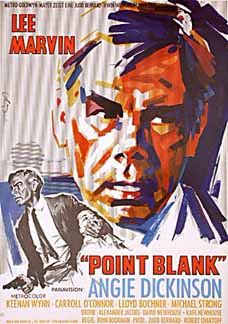 |

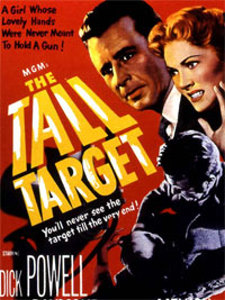 |
The Tall Target. It’s 1861, 90 years before this movie was made.
Abraham Lincoln has just been elected President, and an embattled
police detective (Dick Powell) boards an overnight New York train
bound for Washington to foil an early plot to assassinate him in
Baltimore the following day. Even though we know in advance that
this won’t happen, this being a paranoid, action-packed, atmospheric
thriller directed by noir and western specialist Anthony Mann, and
densely plotted, there’s all kinds of nasty skullduggery on this
eventful train ride. There’s no musical score, salty period
dialogue, and wonderful black and white cinematography by Paul C.
Vogel, full of steam, shiny rails, and claustrophobic enclosures;
Adolphe Menjou and Ruby Dee are especially good. Too bad that no one
has yet seen fit to make this MGM classic available. |

|
The Unfaithful Wife. Claude Chabrol’s
La femme infidèle comes from
1968, when he was specializing in celebrating while caustically
undermining French bourgeois family life. The setup is classic: a
cuckolded husband (Michel Bouquet) calmly sets about plotting the
murder of the man sleeping with his wife (Stephane Audran). Much of
this is deliberately as slow as molasses in its pacing, but never
boring. Chabrol’s ease with this material, and his way of bringing
more and more depth and insight to his subject, never falters, and
the ending manages to be both profound and unexpected. |
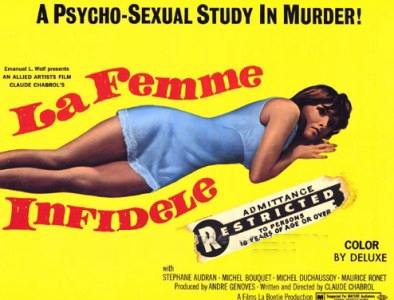 |

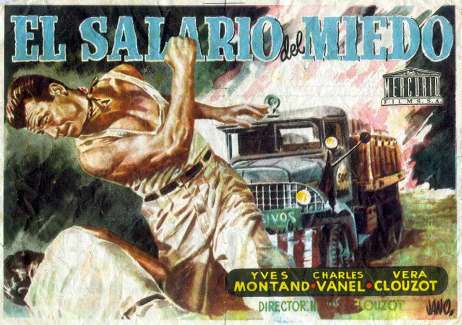 |
The Wages of Fear. Finally, the film I would pick as being the most
suspenseful of all the thrillers I know—-as well as one of the most grueling in terms of gritty details. It centers on four desperate
and unemployed Europeans (Yves Montand, Charles Vanel, Folco Lulli,
Peter Van Eyck) stranded in a dingy South American village that’s
exploited by a greedy American oil company. They agree to drive two
truckloads of nitroglycerine over 300 miles of bumpy, primitive
roads in exchange for $2,000 apiece—-at least if they’re alive at
the end of their run to collect it. When this 1953 existentialist
shocker originally opened in the U.S., 43 of its 148 minutes were
missing (including much of the agitprop about the oil company), but
the action was so strong that it was still a major hit. |
|
Practically all its footage has been restored on DVD,
and now it plays even better. There are things here one
can certainly object to—-misogyny, snobbery, and racism
among them—-as well as things one can applaud because of Clouzot’s
skill and audacity. (Among
other things, this is a passionate love story between
two of the men, Montand and Vanel).
And it’s been so influential that films as various as Cy Endfield’s
Sea Fury and Sam Peckinpah’s
The Wild Bunch would have been
unthinkable without its example. |
|


















